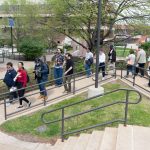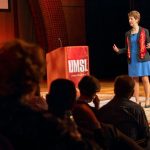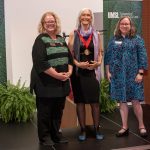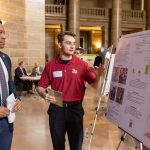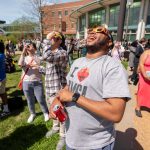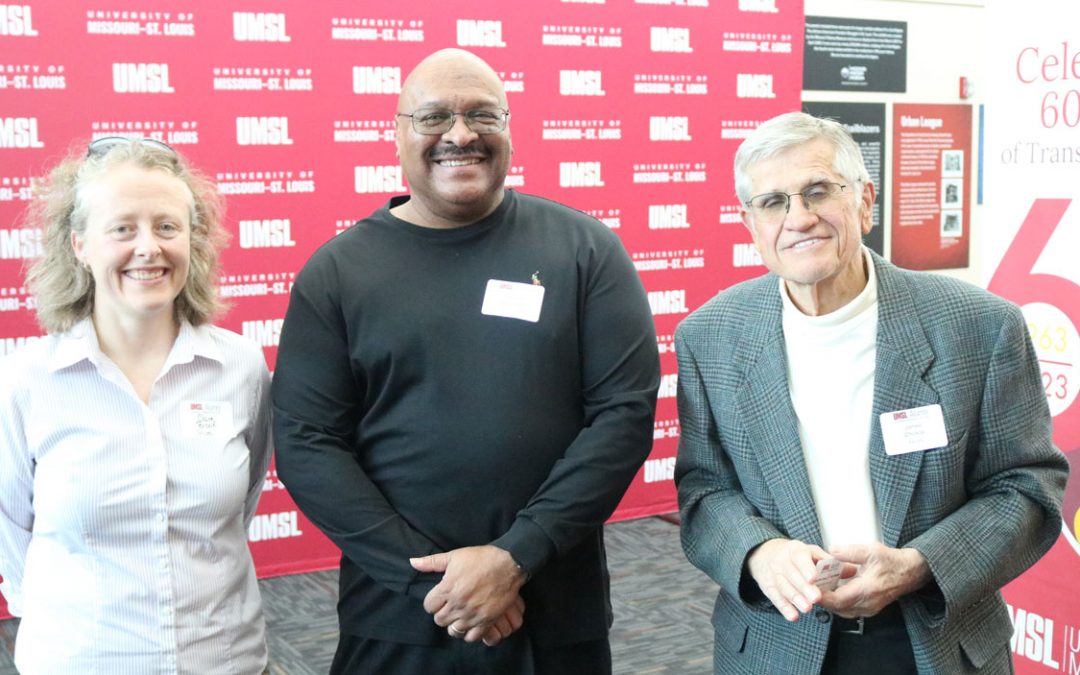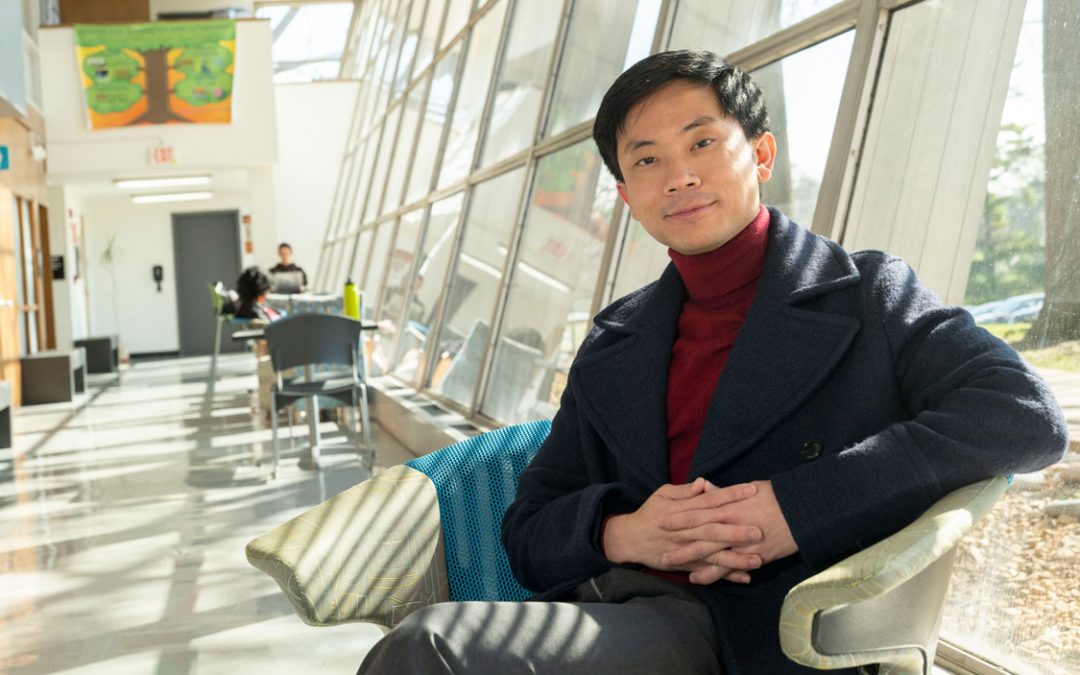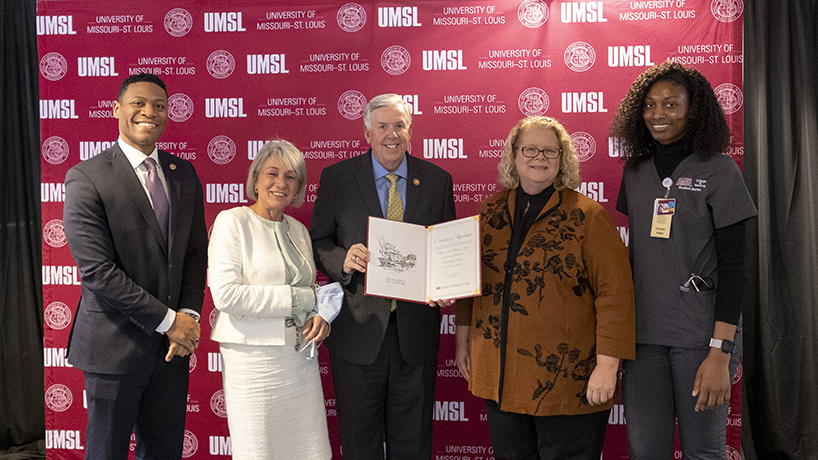
Gov. Mike Parson (center) holds a Certificate of Appreciation for his leadership and support of health care education presented to him by University of Missouri–St. Louis Chancellor Kristin Sobolik during a progress tour of the $7 million Nursing Simulation Labs expansion and renovation. From left: Sen. Brian Williams, College of Nursing Dean Roxanne Vandermause, Parson, Sobolik and BSN student Goodness Ohia Obioha all participated in Tuesday’s event. (Photos by August Jennewein)
With Missouri’s nursing vacancy rate up to 12% statewide, according to the Missouri Hospital Association, getting nurses educated to the highest standard and into the workforce has never been more critical.
Yesterday evening, Missouri Gov. Mike Parson and Sen. Brian Williams joined the University of Missouri–St. Louis community and stakeholders for a progress tour of an UMSL College of Nursing initiative to help address the state’s nursing shortage.
A $7 million, multiphase expansion and renovation of the Nursing Simulation Laboratories, kicked off last November, is designed to address the shortage by increasing the College of Nursing’s capacity to graduate pre-licensure BSN students by 20%. With Phase 1 of the project completed in time for the start of this academic year, the college has begun work on Phase 2.
“Planning for our new Simulation Laboratories actually began a while ago, when it became apparent that the St. Louis region and Missouri as a whole were facing a nursing shortage, a shortage that has become increasingly dire because of the global COVID pandemic,” UMSL Chancellor Kristin Sobolik said. “The expansion of our Simulation Laboratories will allow us to increase undergraduate enrollment and ultimately the number of RNs entering the workforce in health care settings throughout Missouri.”
The in-person event took place in the Seton Center Hall lobby and included remarks by Parson, Sobolik and nursing student Goodness Ohia Obioha. Afterward, College of Nursing Dean Roxanne Vandermause led the progress tour.
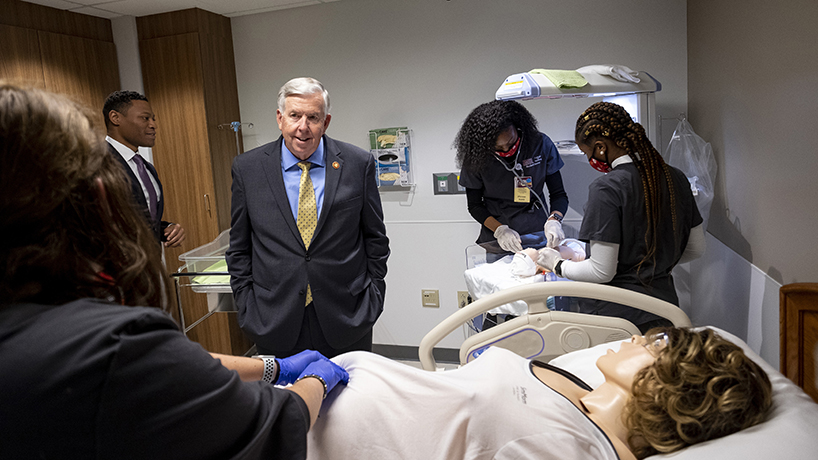
Sen. Brian Williams (left) and Gov. Mike Parson Gov. Mike Parson (center) observe UMSL BSN students in the new College of Nursing Simulation Labs.
In July, Parson directed $1.5 million to the College of Nursing through FY22 state operating budget bills after the Missouri Department of Higher Education and Workforce Development had included the UMSL Nursing Simulation Laboratories among 17 projects totaling $21.8 million that it recommended for funding through the MoExcels Workforce Initiative.
The UMSL project aligns well with the governor’s workforce development priorities. Parson spoke on MoExcels as well as the FastTrack Initiative, which he said has gone to 80% women, the majority of whom have gone into the medical fields.
“When you look at the state of Missouri, with all we’ve been through over the last two years, or close to two years now, dealing with COVID, you see really how important those nurses were in the health care system in our state, and how important this university is to be able to prepare them,” Parson said. “I think that’s why you have to make investments in it. That’s why when you invest in workforce development, it pays off. It’s really what we need to do for the future of this state.”
Phase 1 of the UMSL Nursing Simulation Laboratories included five new labs and a 5,000-square foot expansion into LeGras Hall. It included two pediatric and two obstetrics simulation labs, a skills lab, a home health suite and a control room for instructors. The second phase includes the construction of a large interactive classroom and a renovation of the existing labs in Seton Hall.
Nursing simulation is an increasingly essential component of nursing education and offers an effective and efficient use of the limited faculty and clinical placement resources in the nursing field. More than a substitute for in-person clinical experiences, simulation broadens student competencies as they perform duties that only licensed RNs can perform in the real world and experience high-risk situations infrequent in daily practice.
Effective nursing simulations require a suspension of disbelief by nursing students, explained Obioha, who also works as an assistant in the labs.
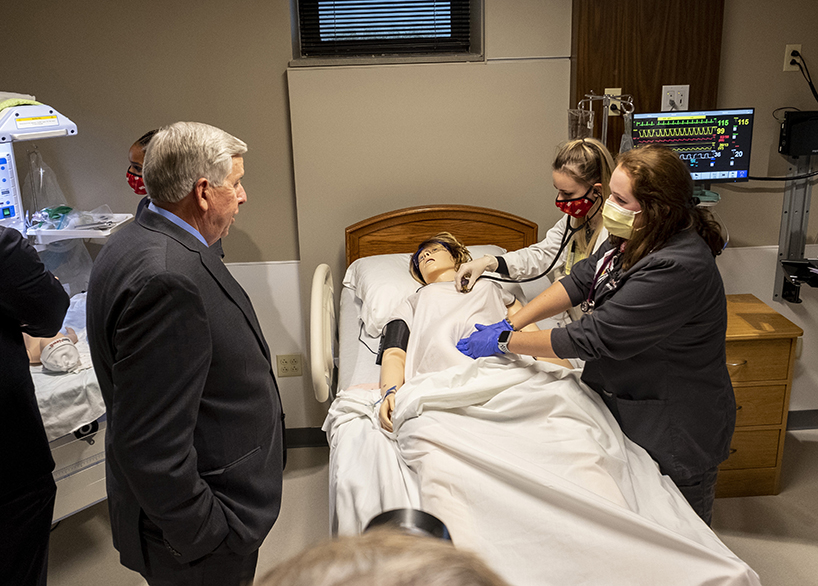
Gov. Mike Parson (left) observes two UMSL BSN students as they demonstrate how learning works in the new College of Nursing Simulation Labs.
“The idea behind it is the mannequin is real, the diagnosis is real, the pain is real, and I am the nurse to assist in this very real situation,” she said.
That’s easier with state-of-the-art, high-fidelity mannequins, which realistically mimic the human body. Additionally, the new labs mirror current hospital technology and setups, which allows students to go seamlessly to clinical settings.
“It feels as close as you can get to a real patient situation,” said Maggie Tiernan, a BSN student demonstrating in an OB/GYN lab. “When I went to OB clinical, I was like, ‘Hey, I actually know what I’m doing. I actually did this.’”
With UMSL’s new labs, instructors have the ability to run the simulations from a separate control room. The instructors can record students’ actions and review and critique them later.
That’s all in service of thinking about what the students might have done differently to produce the best health outcomes for their patients.
“Simulation builds safety,” Ohia Obioha said. “Safety not only for patients through professional development but also safety for us students. Simulation is a safe space for us to learn, meaning that we might not always be perfect, but we learn through our mistakes and how to better our clinical skills.”
Media Coverage
St. Louis Public Radio
Healthy Simulation



